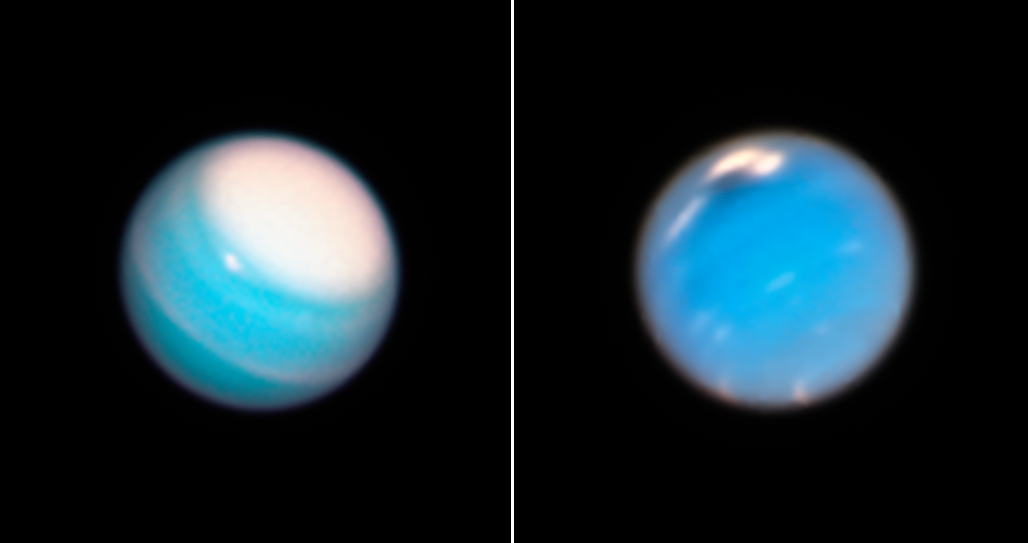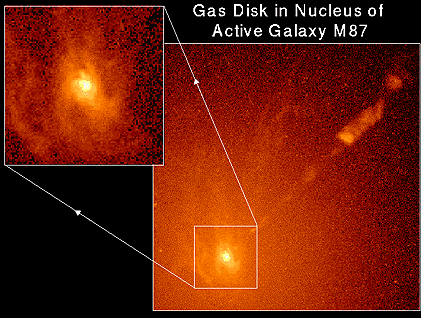CuriousChimp wrote: ↑Thu Jun 11, 2020 10:03 pm
Could the whitening of the background spirals be due to "special" gases and dusts that selectively absorb red and perhaps infrared? Methane andsuch, like the airs of Neptune and Uranus? That would be cool, too.
To my knowledge, foreground dust can never make a background object look whiter. Instead, dust always has a reddening effect. Note how the small dust cloud in the picture at left makes the background stars look progressively redder, until they are blotted out altogether. This means that the dust cloud gets progressively thicker near its center, and the more dust that is present, the stronger is the reddening effect. And of course, the reason why we can't see the center of the Milky Way in optical light is because it is hidden behind
our galaxy's thick dark central dust lane.
I included a picture of Uranus and Neptune because they do owe their blue-green or bluish color to the absorption of deep red and infrared wavelengths due to gaseous methane in their atmospheres. But gas is not dust. I found this tidbit of information on the net:
www.classzone.com wrote:
Uranus looks blue-green, and Neptune appears deep blue. The color comes from methane gas, which absorbs certain colors of light. Each planet has methane gas above a layer of white clouds. Sunlight passes through the gas, reflects off the clouds, then passes through the gas again on its way out.
But there is no way that foreground dust will have a whitening effect on a background object. On the other hand, the apparent color of background galaxies are affected both by their own stellar populations (are they dominated by old red or young blue stars?), their amount of dust, and the way their cosmological redshift affects their apparent colors.
Note three galaxies of similar size lining up in a row diagonally (from right to left) under the Tadpole Galaxy's tail. One galaxy is strikingly blue, while the two others are orange in color. My guess is that the blue galaxy is much closer to us than the two orange ones, and that it is also rich in young blue stars. The two other galaxies look really quite orange, and my guess is that they are strongly reddened by their great distance from us. Note however that they also contain dark markings of dust, and it is quite possible that these galaxies contain quite a lot of dust but few young stars. A good example of a dusty galaxy with almost no star formation is NGC 4216,
seen here in a picture by Ken Siarkiewicz and Adam Block.
In some cases, very tiny and distant background galaxies look very blue. My take on this is that the light that these galaxies originally emitted, and that now reaches us, was strongly dominated by ultraviolet light from massive star formation. But by the time this ultraviolet light reaches us, it has been reddened to shades of blue. You can find such a group of tiny blue galaxies in the left corner of the Tadpole Galaxy image. But near the right edge of the picture is a group of extremely red galaxies. They obviously contain dust, which is usually a sign of the presence of young blue stars. But they could be dusty galaxies whose young stars are only moderately blue like, say, Sirius, so that their light is reddened into something decidedly non-blue. And the galaxies are obviously quite far away - but not as far away as the little group of blue galaxies in the bottom left corner.
Now let's look at the background galaxies seen through the bulge of NGC 1300! As you can see, I have labeled them.
I believe that the galaxy that I have called number 1, the whitest of them, is dominated by star formation. I would guess that this is an intrinsically quite blue galaxy. Its distance has reddened the blue color to white. There is probably very little dust in the bulge of NGC 1300 that could add further reddening.
As for number 2, I find it difficult to guess what it is. It looks tilted, which would mean that it is a disk galaxy. It has a bright core, like most large galaxies. But its disk looks altogether yellow. It could be a lenticular galaxy, a disk galaxy without star formation. Admittedly it looks a bit distorted too, so it could be tidally affected by one or more of its neighboring galaxies.
Galaxy number 3 has a tiny yellow core, surrounded by some wispy mostly non-yellow fluff. I'd say that this is a low-mass spiral galaxy with a tiny yellow core and a fluffy bluish disk with some star formation.
Galaxy number 4 looks like an elliptical galaxy to me. There appears to be a tiny yellow companion galaxy tucked up very close to the core of the large elliptical.
Galaxy number 5 looks like s smallish edge-on galaxy with a moderately bright core and a somewhat irregularly shaped disk without star formation. This galaxy could be unrelated to the other four.
It is also possible that galaxies #1 and #3 form a detached pair, while #2 and #4 form another pair.
Of course, I'm just guessing here.
Ann
 Barred Spiral Galaxy NGC 1300
Barred Spiral Galaxy NGC 1300









